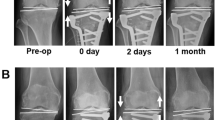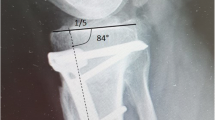Abstract
Purpose
The purpose of this study was to clarify the causes of the increase in the posterior tibial slope during open-wedge high tibial osteotomy (HTO) and to investigate whether its changes influenced the correction angle in frontal plane.
Methods
We retrospectively reviewed 20 patients (26 knees) treated with open-wedge HTO. They were divided into the following two groups. Group A consisted of the knees whose opening gaps were fixed using a spacer plate having the trapezoidal block with a 2° posterior slope. In Group B, anterior and posterior opening gaps were fixed separately. The posterior tibial slope and the hip–knee–ankle angle were measured based on CT data. The relationship between the correction rate in frontal plane and the changes of posterior tibial slope was investigated.
Results
Increase in the posterior tibial slope was 2.1 ± 2.5° in Group A and 0.2 ± 1.2° in Group B, which showed a statistical difference (P = 0.02). The difference between the hip–knee–ankle angles before and after operation was 5.2 ± 2.3° in Group A and 5.5 ± 2.5° in Group B. The correction rate was statistically correlated with the changes of posterior tibial slope (R = −0.55, P = 0.003).
Conclusion
To avoid increase in the posterior tibial slope, the trapezoidal block with a only 2° posterior slope in a spacer plate was not sufficient, and it was necessary to fix anterior and posterior gaps separately. The correction angle in frontal plane had a trade-off relationship with the changes in posterior tibial slope. Thus, we thought that increase in the posterior tibial slope might result in correction loss.
Level of evidence
Therapeutic study, Retrospective comparative study, Level III.





Similar content being viewed by others
References
Aglietti P, Rinonapoli E et al (1983) Tibial osteotomy for the varus osteoarthritic knee. Clin Orthop Relat Res 176:239–251
Agneskirchner JD, Hurschler C et al (2004) Effect of high tibial flexion osteotomy on cartilage pressure and joint kinematics: a biomechanical study in human cadaveric knees. Arch Orthop Trauma Surg 124:575–584
Altman R, Asch E et al (1986) Development of criteria for the classification and reporting of osteoarthritis. Classification of osteoarthritis of the knee. Diagnostic and Therapeutic Criteria Committee of the American Rheumatism Association. Arthritis Rheum 29(8):1039–1049
Bauer GC, Insall J et al (1969) Tibial osteotomy in gonarthrosis (osteo-arthritis of the knee). J Bone Joint Surg Am 51(8):1545–1563
Brouwer RW, Bierma-Zeinstra SM et al (2005) Patellar height and the inclination of the tibial plateau after high tibial osteotomy. The open versus the closed-wedge technique. J Bone Joint Surg Br 87(9):1227–1232
Coventry MB, Ilstrup DM et al (1993) Proximal tibial osteotomy. A critical long-term study of eighty-seven cases. J Bone Joint Surg Am 75(2):196–201
Debeyre J, Frain P (1967) An intercondylar femoral osteotomy technique in the management of knee deviations due to arthrosis. Ann Chir 21:548–553
El-Azab H, Halawa A et al (2008) The effect of closed- and open-wedge high tibial osteotomy on tibial slope: a retrospective radiological review of 120 cases. J Bone Joint Surg Br 90(9):1193–1197
Giffin JR, Vogrin TM et al (2004) Effects of increasing tibial slope on the biomechanics of the knee. Am J Sports Med 32(2):376–382
Hernigou P, Medevielle D et al (1987) Proximal tibial osteotomy for osteoarthritis with varus deformity: a ten to thirteen-year follow up study. J Bone Joint Surg Am 69(3):332–354
Hernigou P (2002) Open wedge tibial osteotomy: combined coronal and sagittal correction. Knee 9(1):15–20
Hinterwimmer S, Beitzel K et al (2011) Control of posterior tibial slope and patellar height in open-wedge valgus high tibial osteotomy. Am J Sports Med 39(4):851–856
Jacobi M, Wahl P et al (2010) Avoiding intraoperative complications in open-wedge high tibial valgus osteotomy: technical advancement. Knee Surg Sports Traumatol Arthrosc 18(2):200–203
Kessler MA, Burkart A et al (2003) Development of a 3-dimensional method to determine the tibial slope with multislice-CT. Z Orthop Ihre Grenzgeb 141:143–147
Marti CB, Gautier E et al (2004) Accuracy of frontal and sagittal plane correction in open-wedge high tibial osteotomy. Arthroscopy 20(4):366–372
Miller BS, Downie B et al (2009) Complications after medial opening wedge high tibial osteotomy. Arthroscopy 25(6):639–646
Noyes FR, Goebel SX et al (2005) Opening wedge tibial osteotomy: the 3-triangle method to correct tibial alignment and tibial slope. Am J Sports Med 33:378–387
Rodner CM, Adams DJ et al (2006) Medial opening wedge tibial osteotomy and the sagittal plane: the effect of increasing tibial slope on tibiofemoral contact pressure. Am J Sports Med 34(9):1431–1441
Rosenberg TD, Paulos LE et al (1988) The forty-five-degree posteroanterior flexion weight-bearing radiograph of the knee. J Bone Joint Surg Am 70(10):1479–1483
Song EK, Seon JK et al (2007) How to avoid unintended increase of posterior slope in navigation-assisted open-wedge high tibial osteotomy. Orthopedics 30(10 Suppl):S127–S131
Spahn G (2004) Complications in high tibial (medial opening wedge) osteotomy. Arch Orthop Trauma Surg 124(10):649–653
Staubli AE, De Simoni C et al (2003) TomoFix: a new LCP-concept for open wedge osteotomy of the medial proximal tibia–early results in 92 cases. Injury 34(Suppl 2):B55–B62
Wang JH, Bae JH et al (2009) Medial open wedge high tibial osteotomy: the effect of the cortical hinge on posterior tibial slope. Am J Sports Med 37(12):2411–2418
Yamamoto T, Bullough PG (2000) Spontaneous osteonecrosis of the knee: the result of subchondral insufficiency fracture. J Bone Joint Surg Am 82(6):858–866
Yates PJ, Calder JD et al (2007) Early MRI diagnosis and non-surgical management of spontaneous osteonecrosis of the knee. Knee 14(2):112–116
Ethical board review statement
All patients agreed to participate in the study. The patient consent procedure strictly involved disclosure, understanding, and voluntariness. The study protocol was noted to accord with a criterion of the Institutional Review Board in the Kinki University Hospital that the approval of the committee is not needed.
Conflict of interest
All authors do not have any financial support and any competing interest with regard to this manuscript.
Author information
Authors and Affiliations
Corresponding author
Rights and permissions
About this article
Cite this article
Asada, S., Akagi, M., Mori, S. et al. Increase in posterior tibial slope would result in correction loss in frontal plane after medial open-wedge high tibial osteotomy. Knee Surg Sports Traumatol Arthrosc 20, 571–578 (2012). https://doi.org/10.1007/s00167-011-1610-1
Received:
Accepted:
Published:
Issue Date:
DOI: https://doi.org/10.1007/s00167-011-1610-1




